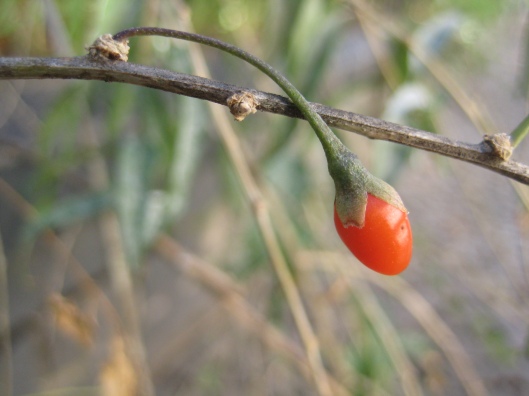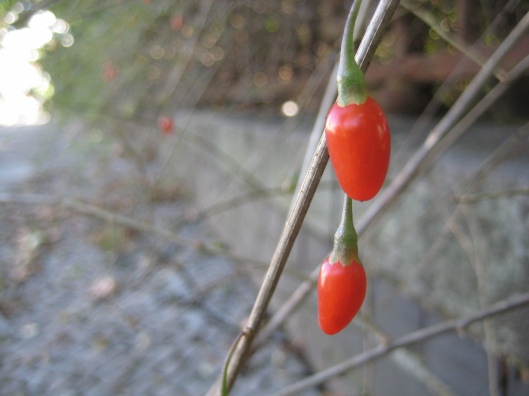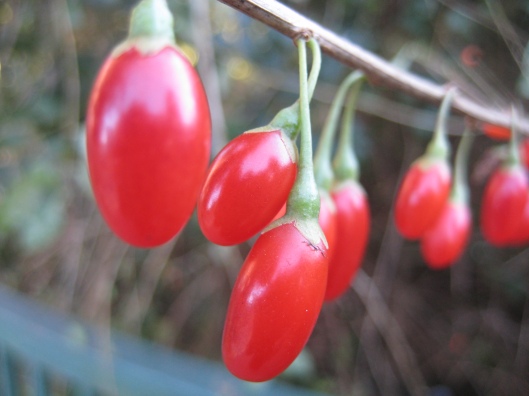Tags
antioxidants, berries, chinese medicine, edible, ethnobotany, fall, foraging, goji berry, longevity, nature, nightshade, october, purple flower, shrub, superfruit, urban foraging, vitamin c, wolfberry
A few posts ago we featured the split personality of the European yew: lowly hedge yet powerful, magnificent tree. Today we focus on wolfberry (Lycium barbarum or the closely related Lycium chinense), a hedge plant in Berlin whose double life illustrates the slow-shifting cultural landscape of food. Although the Lycium barbarum is native to both Asia and southeastern Europe, it was first introduced into the UK in the 18th century by Archibald Campbell, an enthusiastic gardener and the 3rd Duke of Argyll (hence another common name for the plant is Duke of Argyll’s tea tree). From here on, the sprawling bush has grown wild in hedgerows or has been used sporadically around Europe as a wind barrier. The characteristic flower betrays its membership in the infamous Nightshade family, and the mature ovoid red berries suspiciously resemble the toxic Amara Dulcis (Solanum dulcamara) fruits. This is most likely why the ripe berries were regarded as poisonous and wolfberry has primarily been valued for its menial hedging habits. In Germany, the toxicity of the plant was investigated in the late 19th century in a doctoral dissertation published in Erlangen. The thesis claimed that Lycium spp. contain pupil-dilating substances, a hallmark of nightshade plants such as Belladonna (Atropa belladonna). As a result, wolfberry fruits were not considered edible until their recent introduction into health food markets as the much awaited panacea from the Far East: Goji berries.
Goji berries have a long, distinguished history in traditional Chinese medicine, from being used to improve vision, cure infertility and dry cough to loftier claims of extending longevity. The berries are consumed in a variety of ways: eaten raw or consumed as fresh juice, wine or tea. The dried berries are often featured in soups. When goji berries were “introduced” in Europe, they were accompanied by incredible medical claims of fighting cancer, and preventing premature aging and memory loss. Regardless of the validity of these medical claims, the berries are chock full of vitamins, minerals and antioxidants. Such treasures come with a heavy price tag; you can expect to pay a minimum of 20 euros per kilogram of dried goji berries in most organic health food stores in Berlin. Meanwhile, among German plant aficionados, an atmosphere of confusion ensues as many find it hard to believe that wolfberry, which is considered an invasive weed, is the source of goji berries. Well, dear reader, rest assured! You can gather goji berries all over Berlin, and they are not toxic (for a recent article on the pharmacology of goji berries see here). However, care must be taken not to mistake the plant for the toxic Amara Dulcis. There is also a potential risk of drug interaction when consuming goji berries, in particular with blood thinners such as Warfarin.
We found wolfberry shrubs along the northern side of the S-bahn ring, west of Schönhauser Alle. All the berries were already gone (as you can see in a picture below) and we were quite disappointed, thinking we would have to wait another year for the harvest. On a whim of the moment, we decided to explore a bit further west in Wedding, looking for interesting plants and keeping our eyes open for goji berries as we walked along the small Panke River. As you can tell from the pictures, our optimism was handsomely rewarded by a bowl full of goji berries! The raw berries are somewhat of an acquired taste, as the initial sweetness of the fruit is followed by a potent, lingering bitterness. We are therefore drying the harvested berries (which should reduce the bitterness) and plan on using them in soups and teas!





Great post. The more I learn about plants, the more I learn about how ignorant our “developed” cultures are, and how often we overlook the common place, until it arrives in an exotic form.
Love how much you have been focusing on members of the nightshade family.
Thanks, Nathan. We were just talking about this the other day… it’s amazing how much we overlook the local plants that surround us. And once you identify a plant and learn a bit about it, you suddenly start seeing it everywhere!
The nightshade family has indeed been featured in many of our posts… it is such a fascinating and varied family of plants that we can’t help it! We thought we had finished our nightshade series but it seems that we are just beginning…
So glad you also appreciate these beautiful plants!
Hi, I am staying as an au pair with a family in Berlin. They live in Karow and there is a plant in the front of the house that nobody can identify. The berries look just like those in your pictures, however they don’t have a green part wrapped around the edge. Would these be the toxic Amara Dulcis which you spoke of? Furthermore, what is the difference between the two plants. I am interested in hunting for some goji berries in the next week. Thank you for your very helpful post!
Hi Surah, Thanks for your comment!The Amara Dulcis berries can easily be distinguished from goji berries because they are closely clustered together. They branch off of each other… take a look at this wikipedia image and you’ll see what I mean: http://en.wikipedia.org/wiki/File:Illustration_Solanum_dulcamara0.jpg
If you’d like to send us a picture of your berries we’d be happy to help you identify the plant! And happy goji berry hunting 🙂